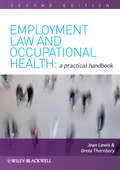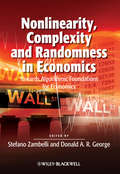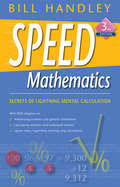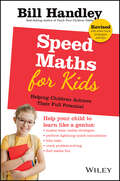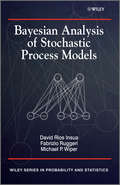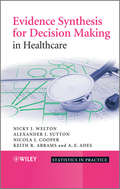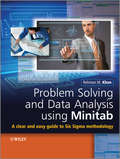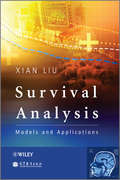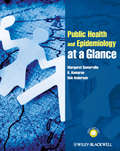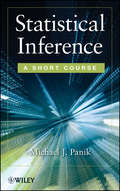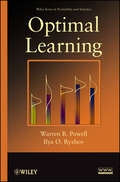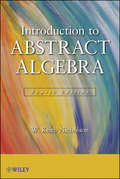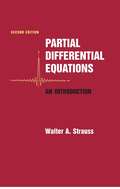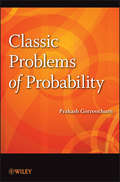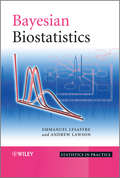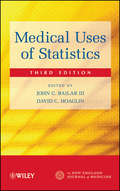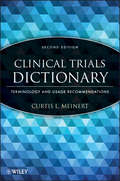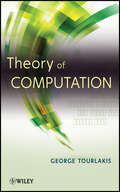- Table View
- List View
Employment Law and Occupational Health: A Practical Handbook
by Joan Lewis Greta Thornbory'Employment Law and Occupational Health: A Practical Handbook' provides an essential guide to best practice for all occupational health practitioners. This readable guide to the law will help to ensure both business success and respect for individual employment rights. The cost of sickness absence can present major costs and business management problems. Safeguarding health is therefore vital to both individuals and employers. 'Employment Law and Occupational Health' explores key issues in occupational health practice from pre-employment, through health surveillance and occupational health services, to termination of employment. Topics explored include ethical and confidentiality issues, discrimination, data protection, working abroad, pregnancy and maternity leave, workplace policies, drugs and alcohol testing, stress, counselling, health surveillance and professional conduct rules. This second edition has been fully revised and updated to include a number of significant changes to employment law as well as new case law decisions that have occurred since the 1st Edition was published. Essential new material has also been included around age discrimination, disability discrimination, work related stress, corporate manslaughter and work-place bullying. An accessible, practical guide to applying health law in everyday practice. For occupational health nurses and other occupational health practitioners. Addresses key employment issues from pre-employment to termination of employment. Includes case studies, procedural checklists, and template letters and forms.
Nonlinearity, Complexity and Randomness in Economics: Towards Algorithmic Foundations for Economics (Surveys of Recent Research in Economics #8)
by Stefano Zambelli Donald A. R. GeorgeNonlinearity, Complexity and Randomness in Economics presents a variety of papers by leading economists, scientists, and philosophers who focus on different aspects of nonlinearity, complexity and randomness, and their implications for economics. A theme of the book is that economics should be based on algorithmic, computable mathematical foundations. Features an interdisciplinary collection of papers by economists, scientists, and philosophers Presents new approaches to macroeconomic modelling, agent-based modelling, financial markets, and emergent complexity Reveals how economics today must be based on algorithmic, computable mathematical foundations
Nonlinearity, Complexity and Randomness in Economics: Towards Algorithmic Foundations for Economics (Surveys of Recent Research in Economics #9)
by Stefano Zambelli Donald A.R. GeorgeNonlinearity, Complexity and Randomness in Economics presents a variety of papers by leading economists, scientists, and philosophers who focus on different aspects of nonlinearity, complexity and randomness, and their implications for economics. A theme of the book is that economics should be based on algorithmic, computable mathematical foundations. Features an interdisciplinary collection of papers by economists, scientists, and philosophers Presents new approaches to macroeconomic modelling, agent-based modelling, financial markets, and emergent complexity Reveals how economics today must be based on algorithmic, computable mathematical foundations
Speed Mathematics: Secrets Skills For Quick Calculation
by Bill HandleyThis new, revised edition of the bestselling Speed Mathematics features new chapters on memorising numbers and general information, calculating statistics and compound interest, square roots, logarithms and easy trig calculations. Written so anyone can understand, this book teaches simple strategies that will enable readers to make lightning-quick calculations. People who excel at mathematics use better strategies than the rest of us; they are not necessarily more intelligent. With Speed Mathematics you'll discover methods to make maths easy and fun. This book is perfect for students, parents, teachers and anyone who enjoys working with figures and even those who are terrified of numbers!
Speed Math for Kids: Helping Children Achieve Their Full Potential
by Bill HandleyPopular Australian author and inspirational teacher, Bill Handley, has developed and, over the years, refined methods of teaching mathematics and learning strategies that have achieved amazing results. His best-selling book, Speed Mathematics convinced readers that people who excel at maths use better strategies and are not necessarily more intelligent. This book contains additional methods and applications based on the strategies taught in Speed Mathematics that make the principles clearer, encourage creative thought, and are just plain fun. The book was written for young people but people of any age will enjoy it. The book has notes throughout for parents and teachers. By following his innovative approach you will have kids playing with numbers, performing lightning quick calculations and, most of all, having fun! Bill claims: 'If you are good at maths, people think you are intelligent. People will treat you like you are a genius. Your teachers and your friends will treat you differently. You will even think differently about yourself'. The emphasis in this book is on playing with mathematics. Enjoy it. Show off what you learn and make mathematics your favourite subject.
Speed Maths for Kids: Helping Children Achieve Their Full Potential
by Bill HandleyUPDATED 2022What if you could teach your kids simple maths strategies that can be applied to almost any calculation? What if you could show them that learning maths can be fun? Popular Australian author and inspirational teacher Bill Handley&’s methods of teaching mathematics and learning strategies have achieved amazing results. In this bestselling book, he shows readers that kids who excel at maths are not necessarily more intelligent—they simply use better strategies! Speed Maths for Kids makes the methods and principles for maths calculations clearer, encourages creative thought, and is just plain fun. Now fully revised with new chapters and strategies, the book also has notes throughout for parents and teachers to help their children engage and learn more easily. Help your child: Learn to enjoy maths Tackle tests without the stress Achieve better results on quizzes, NAPLAN, and exams By following Handley&’s innovative approach, you will have kids playing with numbers, performing lightning-quick calculations and, most of all, having fun! Give your child a boost in school—and make mathematics their favourite subject.
Bayesian Analysis of Stochastic Process Models (Wiley Series in Probability and Statistics #978)
by David Insua Fabrizio Ruggeri Mike WiperBayesian analysis of complex models based on stochastic processes has in recent years become a growing area. This book provides a unified treatment of Bayesian analysis of models based on stochastic processes, covering the main classes of stochastic processing including modeling, computational, inference, forecasting, decision making and important applied models. Key features: Explores Bayesian analysis of models based on stochastic processes, providing a unified treatment. Provides a thorough introduction for research students. Computational tools to deal with complex problems are illustrated along with real life case studies Looks at inference, prediction and decision making. Researchers, graduate and advanced undergraduate students interested in stochastic processes in fields such as statistics, operations research (OR), engineering, finance, economics, computer science and Bayesian analysis will benefit from reading this book. With numerous applications included, practitioners of OR, stochastic modelling and applied statistics will also find this book useful.
Evidence Synthesis for Decision Making in Healthcare (Statistics in Practice #127)
by Nicky J. Welton Alexander J. Sutton Nicola Cooper Keith R. Abrams A. E. AdesIn the evaluation of healthcare, rigorous methods of quantitative assessment are necessary to establish interventions that are both effective and cost-effective. Usually a single study will not fully address these issues and it is desirable to synthesize evidence from multiple sources. This book aims to provide a practical guide to evidence synthesis for the purpose of decision making, starting with a simple single parameter model, where all studies estimate the same quantity (pairwise meta-analysis) and progressing to more complex multi-parameter structures (including meta-regression, mixed treatment comparisons, Markov models of disease progression, and epidemiology models). A comprehensive, coherent framework is adopted and estimated using Bayesian methods. Key features: A coherent approach to evidence synthesis from multiple sources. Focus is given to Bayesian methods for evidence synthesis that can be integrated within cost-effectiveness analyses in a probabilistic framework using Markov Chain Monte Carlo simulation. Provides methods to statistically combine evidence from a range of evidence structures. Emphasizes the importance of model critique and checking for evidence consistency. Presents numerous worked examples, exercises and solutions drawn from a variety of medical disciplines throughout the book. WinBUGS code is provided for all examples. Evidence Synthesis for Decision Making in Healthcare is intended for health economists, decision modelers, statisticians and others involved in evidence synthesis, health technology assessment, and economic evaluation of health technologies.
Problem Solving and Data Analysis Using Minitab: A Clear and Easy Guide to Six Sigma Methodology
by Rehman M. KhanSix Sigma statistical methodology using Minitab Problem Solving and Data Analysis using Minitab presents example-based learning to aid readers in understanding how to use MINITAB 16 for statistical analysis and problem solving. Each example and exercise is broken down into the exact steps that must be followed in order to take the reader through key learning points and work through complex analyses. Exercises are featured at the end of each example so that the reader can be assured that they have understood the key learning points. Key features: Provides readers with a step by step guide to problem solving and statistical analysis using Minitab 16 which is also compatible with version 15. Includes fully worked examples with graphics showing menu selections and Minitab outputs. Uses example based learning that the reader can work through at their pace. Contains hundreds of screenshots to aid the reader, along with explanations of the statistics being performed and interpretation of results. Presents the core statistical techniques used by Six Sigma Black Belts. Contains examples, exercises and solutions throughout, and is supported by an accompanying website featuring the numerous example data sets. Making Six Sigma statistical methodology accessible to beginners, this book is aimed at numerical professionals, students or academics who wish to learn and apply statistical techniques for problem solving, process improvement or data analysis whilst keeping mathematical theory to a minimum.
Problem Solving and Data Analysis Using Minitab: A Clear and Easy Guide to Six Sigma Methodology
by Rehman M. KhanSix Sigma statistical methodology using Minitab Problem Solving and Data Analysis using Minitab presents example-based learning to aid readers in understanding how to use MINITAB 16 for statistical analysis and problem solving. Each example and exercise is broken down into the exact steps that must be followed in order to take the reader through key learning points and work through complex analyses. Exercises are featured at the end of each example so that the reader can be assured that they have understood the key learning points. Key features: Provides readers with a step by step guide to problem solving and statistical analysis using Minitab 16 which is also compatible with version 15. Includes fully worked examples with graphics showing menu selections and Minitab outputs. Uses example based learning that the reader can work through at their pace. Contains hundreds of screenshots to aid the reader, along with explanations of the statistics being performed and interpretation of results. Presents the core statistical techniques used by Six Sigma Black Belts. Contains examples, exercises and solutions throughout, and is supported by an accompanying website featuring the numerous example data sets. Making Six Sigma statistical methodology accessible to beginners, this book is aimed at numerical professionals, students or academics who wish to learn and apply statistical techniques for problem solving, process improvement or data analysis whilst keeping mathematical theory to a minimum.
Survival Analysis: Models and Applications
by Xian LiuSurvival analysis concerns sequential occurrences of events governed by probabilistic laws. Recent decades have witnessed many applications of survival analysis in various disciplines. This book introduces both classic survival models and theories along with newly developed techniques. Readers will learn how to perform analysis of survival data by following numerous empirical illustrations in SAS. Survival Analysis: Models and Applications: Presents basic techniques before leading onto some of the most advanced topics in survival analysis. Assumes only a minimal knowledge of SAS whilst enabling more experienced users to learn new techniques of data input and manipulation. Provides numerous examples of SAS code to illustrate each of the methods, along with step-by-step instructions to perform each technique. Highlights the strengths and limitations of each technique covered. Covering a wide scope of survival techniques and methods, from the introductory to the advanced, this book can be used as a useful reference book for planners, researchers, and professors who are working in settings involving various lifetime events. Scientists interested in survival analysis should find it a useful guidebook for the incorporation of survival data and methods into their projects.
Public Health and Epidemiology at a Glance (At a Glance #72)
by Margaret Somerville K. Kumaran Rob AndersonThis brand new title in the market-leading at a Glance series provides a highly-illustrated, visual introduction to the key concepts of population-level disease prevention. Accessible, double-page spreads help you understand and appreciate the determinants of health which impact on healthcare services and their effectiveness. Public Health and Epidemiology at a Glance features high-yield information on all the topics covered at medical school, including: Measurement of population health Epidemiological concepts of cause and association, surveillance, and risk Use of epidemiology in clinical decision-making Epidemiology of major health problems such as cardiovascular disease and cancer Health promotion Basics of health economics Basics of health policy, needs assessment, and evaluation Also featuring self-assessment questions to help test learning, this new title will provide an invaluable resource for medical and healthcare students, junior doctors, and those preparing for a career in public health.
Statistical Inference: A Short Course
by Michael J. PanikA concise, easily accessible introduction to descriptive and inferential techniques Statistical Inference: A Short Course offers a concise presentation of the essentials of basic statistics for readers seeking to acquire a working knowledge of statistical concepts, measures, and procedures. The author conducts tests on the assumption of randomness and normality, provides nonparametric methods when parametric approaches might not work. The book also explores how to determine a confidence interval for a population median while also providing coverage of ratio estimation, randomness, and causality. To ensure a thorough understanding of all key concepts, Statistical Inference provides numerous examples and solutions along with complete and precise answers to many fundamental questions, including: How do we determine that a given dataset is actually a random sample? With what level of precision and reliability can a population sample be estimated? How are probabilities determined and are they the same thing as odds? How can we predict the level of one variable from that of another? What is the strength of the relationship between two variables? The book is organized to present fundamental statistical concepts first, with later chapters exploring more advanced topics and additional statistical tests such as Distributional Hypotheses, Multinomial Chi-Square Statistics, and the Chi-Square Distribution. Each chapter includes appendices and exercises, allowing readers to test their comprehension of the presented material. Statistical Inference: A Short Course is an excellent book for courses on probability, mathematical statistics, and statistical inference at the upper-undergraduate and graduate levels. The book also serves as a valuable reference for researchers and practitioners who would like to develop further insights into essential statistical tools.
Statistical Inference: A Short Course
by Michael J. PanikA concise, easily accessible introduction to descriptive and inferential techniques Statistical Inference: A Short Course offers a concise presentation of the essentials of basic statistics for readers seeking to acquire a working knowledge of statistical concepts, measures, and procedures. The author conducts tests on the assumption of randomness and normality, provides nonparametric methods when parametric approaches might not work. The book also explores how to determine a confidence interval for a population median while also providing coverage of ratio estimation, randomness, and causality. To ensure a thorough understanding of all key concepts, Statistical Inference provides numerous examples and solutions along with complete and precise answers to many fundamental questions, including: How do we determine that a given dataset is actually a random sample? With what level of precision and reliability can a population sample be estimated? How are probabilities determined and are they the same thing as odds? How can we predict the level of one variable from that of another? What is the strength of the relationship between two variables? The book is organized to present fundamental statistical concepts first, with later chapters exploring more advanced topics and additional statistical tests such as Distributional Hypotheses, Multinomial Chi-Square Statistics, and the Chi-Square Distribution. Each chapter includes appendices and exercises, allowing readers to test their comprehension of the presented material. Statistical Inference: A Short Course is an excellent book for courses on probability, mathematical statistics, and statistical inference at the upper-undergraduate and graduate levels. The book also serves as a valuable reference for researchers and practitioners who would like to develop further insights into essential statistical tools.
Optimal Learning (Wiley Series in Probability and Statistics #841)
by Warren B. Powell Ilya O. RyzhovLearn the science of collecting information to make effective decisions Everyday decisions are made without the benefit of accurate information. Optimal Learning develops the needed principles for gathering information to make decisions, especially when collecting information is time-consuming and expensive. Designed for readers with an elementary background in probability and statistics, the book presents effective and practical policies illustrated in a wide range of applications, from energy, homeland security, and transportation to engineering, health, and business. This book covers the fundamental dimensions of a learning problem and presents a simple method for testing and comparing policies for learning. Special attention is given to the knowledge gradient policy and its use with a wide range of belief models, including lookup table and parametric and for online and offline problems. Three sections develop ideas with increasing levels of sophistication: Fundamentals explores fundamental topics, including adaptive learning, ranking and selection, the knowledge gradient, and bandit problems Extensions and Applications features coverage of linear belief models, subset selection models, scalar function optimization, optimal bidding, and stopping problems Advanced Topics explores complex methods including simulation optimization, active learning in mathematical programming, and optimal continuous measurements Each chapter identifies a specific learning problem, presents the related, practical algorithms for implementation, and concludes with numerous exercises. A related website features additional applications and downloadable software, including MATLAB and the Optimal Learning Calculator, a spreadsheet-based package that provides an introduction to learning and a variety of policies for learning.
Optimal Learning (Wiley Series in Probability and Statistics #841)
by Warren B. Powell Ilya O. RyzhovLearn the science of collecting information to make effective decisions Everyday decisions are made without the benefit of accurate information. Optimal Learning develops the needed principles for gathering information to make decisions, especially when collecting information is time-consuming and expensive. Designed for readers with an elementary background in probability and statistics, the book presents effective and practical policies illustrated in a wide range of applications, from energy, homeland security, and transportation to engineering, health, and business. This book covers the fundamental dimensions of a learning problem and presents a simple method for testing and comparing policies for learning. Special attention is given to the knowledge gradient policy and its use with a wide range of belief models, including lookup table and parametric and for online and offline problems. Three sections develop ideas with increasing levels of sophistication: Fundamentals explores fundamental topics, including adaptive learning, ranking and selection, the knowledge gradient, and bandit problems Extensions and Applications features coverage of linear belief models, subset selection models, scalar function optimization, optimal bidding, and stopping problems Advanced Topics explores complex methods including simulation optimization, active learning in mathematical programming, and optimal continuous measurements Each chapter identifies a specific learning problem, presents the related, practical algorithms for implementation, and concludes with numerous exercises. A related website features additional applications and downloadable software, including MATLAB and the Optimal Learning Calculator, a spreadsheet-based package that provides an introduction to learning and a variety of policies for learning.
Introduction to Abstract Algebra (The\prindle, Weber And Schmidt Series In Mathematics)
by W. Keith NicholsonPraise for the Third Edition ". . . an expository masterpiece of the highest didactic value that has gained additional attractivity through the various improvements . . ."—Zentralblatt MATH The Fourth Edition of Introduction to Abstract Algebra continues to provide an accessible approach to the basic structures of abstract algebra: groups, rings, and fields. The book's unique presentation helps readers advance to abstract theory by presenting concrete examples of induction, number theory, integers modulo n, and permutations before the abstract structures are defined. Readers can immediately begin to perform computations using abstract concepts that are developed in greater detail later in the text. The Fourth Edition features important concepts as well as specialized topics, including: The treatment of nilpotent groups, including the Frattini and Fitting subgroups Symmetric polynomials The proof of the fundamental theorem of algebra using symmetric polynomials The proof of Wedderburn's theorem on finite division rings The proof of the Wedderburn-Artin theorem Throughout the book, worked examples and real-world problems illustrate concepts and their applications, facilitating a complete understanding for readers regardless of their background in mathematics. A wealth of computational and theoretical exercises, ranging from basic to complex, allows readers to test their comprehension of the material. In addition, detailed historical notes and biographies of mathematicians provide context for and illuminate the discussion of key topics. A solutions manual is also available for readers who would like access to partial solutions to the book's exercises. Introduction to Abstract Algebra, Fourth Edition is an excellent book for courses on the topic at the upper-undergraduate and beginning-graduate levels. The book also serves as a valuable reference and self-study tool for practitioners in the fields of engineering, computer science, and applied mathematics.
Partial Differential Equations: An Introduction, Enhanced ePub
by Walter A. StraussOur understanding of the fundamental processes of the natural world is based to a large extent on partial differential equations (PDEs). The second edition of Partial Differential Equations provides an introduction to the basic properties of PDEs and the ideas and techniques that have proven useful in analyzing them. It provides the student a broad perspective on the subject, illustrates the incredibly rich variety of phenomena encompassed by it, and imparts a working knowledge of the most important techniques of analysis of the solutions of the equations. In this book mathematical jargon is minimized. Our focus is on the three most classical PDEs: the wave, heat and Laplace equations. Advanced concepts are introduced frequently but with the least possible technicalities. The book is flexibly designed for juniors, seniors or beginning graduate students in science, engineering or mathematics.
Classic Problems of Probability
by Prakash GorroochurnWinner of the 2012 PROSE Award for Mathematics from The American Publishers Awards for Professional and Scholarly Excellence. "A great book, one that I will certainly add to my personal library." —Paul J. Nahin, Professor Emeritus of Electrical Engineering, University of New Hampshire Classic Problems of Probability presents a lively account of the most intriguing aspects of statistics. The book features a large collection of more than thirty classic probability problems which have been carefully selected for their interesting history, the way they have shaped the field, and their counterintuitive nature. From Cardano's 1564 Games of Chance to Jacob Bernoulli's 1713 Golden Theorem to Parrondo's 1996 Perplexing Paradox, the book clearly outlines the puzzles and problems of probability, interweaving the discussion with rich historical detail and the story of how the mathematicians involved arrived at their solutions. Each problem is given an in-depth treatment, including detailed and rigorous mathematical proofs as needed. Some of the fascinating topics discussed by the author include: Buffon's Needle problem and its ingenious treatment by Joseph Barbier, culminating into a discussion of invariance Various paradoxes raised by Joseph Bertrand Classic problems in decision theory, including Pascal's Wager, Kraitchik's Neckties, and Newcomb's problem The Bayesian paradigm and various philosophies of probability Coverage of both elementary and more complex problems, including the Chevalier de Méré problems, Fisher and the lady testing tea, the birthday problem and its various extensions, and the Borel-Kolmogorov paradox Classic Problems of Probability is an eye-opening, one-of-a-kind reference for researchers and professionals interested in the history of probability and the varied problem-solving strategies employed throughout the ages. The book also serves as an insightful supplement for courses on mathematical probability and introductory probability and statistics at the undergraduate level.
Classic Problems of Probability
by Prakash GorroochurnWinner of the 2012 PROSE Award for Mathematics from The American Publishers Awards for Professional and Scholarly Excellence. "A great book, one that I will certainly add to my personal library." —Paul J. Nahin, Professor Emeritus of Electrical Engineering, University of New Hampshire Classic Problems of Probability presents a lively account of the most intriguing aspects of statistics. The book features a large collection of more than thirty classic probability problems which have been carefully selected for their interesting history, the way they have shaped the field, and their counterintuitive nature. From Cardano's 1564 Games of Chance to Jacob Bernoulli's 1713 Golden Theorem to Parrondo's 1996 Perplexing Paradox, the book clearly outlines the puzzles and problems of probability, interweaving the discussion with rich historical detail and the story of how the mathematicians involved arrived at their solutions. Each problem is given an in-depth treatment, including detailed and rigorous mathematical proofs as needed. Some of the fascinating topics discussed by the author include: Buffon's Needle problem and its ingenious treatment by Joseph Barbier, culminating into a discussion of invariance Various paradoxes raised by Joseph Bertrand Classic problems in decision theory, including Pascal's Wager, Kraitchik's Neckties, and Newcomb's problem The Bayesian paradigm and various philosophies of probability Coverage of both elementary and more complex problems, including the Chevalier de Méré problems, Fisher and the lady testing tea, the birthday problem and its various extensions, and the Borel-Kolmogorov paradox Classic Problems of Probability is an eye-opening, one-of-a-kind reference for researchers and professionals interested in the history of probability and the varied problem-solving strategies employed throughout the ages. The book also serves as an insightful supplement for courses on mathematical probability and introductory probability and statistics at the undergraduate level.
Bayesian Biostatistics (Statistics in Practice)
by Emmanuel Lesaffre Andrew B. LawsonThe growth of biostatistics has been phenomenal in recent years and has been marked by considerable technical innovation in both methodology and computational practicality. One area that has experienced significant growth is Bayesian methods. The growing use of Bayesian methodology has taken place partly due to an increasing number of practitioners valuing the Bayesian paradigm as matching that of scientific discovery. In addition, computational advances have allowed for more complex models to be fitted routinely to realistic data sets. Through examples, exercises and a combination of introductory and more advanced chapters, this book provides an invaluable understanding of the complex world of biomedical statistics illustrated via a diverse range of applications taken from epidemiology, exploratory clinical studies, health promotion studies, image analysis and clinical trials. Key Features: Provides an authoritative account of Bayesian methodology, from its most basic elements to its practical implementation, with an emphasis on healthcare techniques. Contains introductory explanations of Bayesian principles common to all areas of application. Presents clear and concise examples in biostatistics applications such as clinical trials, longitudinal studies, bioassay, survival, image analysis and bioinformatics. Illustrated throughout with examples using software including WinBUGS, OpenBUGS, SAS and various dedicated R programs. Highlights the differences between the Bayesian and classical approaches. Supported by an accompanying website hosting free software and case study guides. Bayesian Biostatistics introduces the reader smoothly into the Bayesian statistical methods with chapters that gradually increase in level of complexity. Master students in biostatistics, applied statisticians and all researchers with a good background in classical statistics who have interest in Bayesian methods will find this book useful.
Medical Uses of Statistics
by John C. Bailar David C. HoaglinA new edition of the classic guide to the use of statistics in medicine, featuring examples from articles in the New England Journal of Medicine Medical Uses of Statistics has served as one of the most influential works on the subject for physicians, physicians-in-training, and a myriad of healthcare experts who need a clear idea of the proper application of statistical techniques in clinical studies as well as the implications of their interpretation for clinical practice. This Third Edition maintains the focus on the critical ideas, rather than the mechanics, to give practitioners and students the resources they need to understand the statistical methods they encounter in modern medical literature. Bringing together contributions from more than two dozen distinguished statisticians and medical doctors, this volume stresses the underlying concepts in areas such as randomized trials, survival analysis, genetics, linear regression, meta-analysis, and risk analysis. The Third Edition includes: Numerous examples based on studies taken directly from the pages of the New England Journal of Medicine Two added chapters on statistics in genetics Two new chapters on the application of statistical methods to studies in epidemiology New chapters on analyses of randomized trials, linear regression, categorical data analysis, meta-analysis, subgroup analyses, and risk analysis Updated chapters on statistical thinking, crossover designs, p-values, survival analysis, and reporting research results A focus on helping readers to critically interpret published results of clinical research Medical Uses of Statistics, Third Edition is a valuable resource for researchers and physicians working in any health-related field. It is also an excellent supplemental book for courses on medicine, biostatistics, and clinical research at the upper-undergraduate and graduate levels. You can also visit the New England Journal of Medicine website for related information.
Clinical Trials Dictionary: Terminology and Usage Recommendations
by Curtis L. MeinertA thoroughly updated new edition of the essential reference on the design, practice, and analysis of clinical trials Clinical Trials Dictionary: Terminology and Usage Recommendations, Second Edition presents clear, precise, meticulously detailed entries on all aspects of modern-day clinical trials. Written and compiled by one of the world’s leading clinical trialists, this comprehensive volume incorporates areas of medicine, statistics, epidemiology, computer science, and bioethics—providing a treasure trove of key terms and ideas. This new edition continues to supply readers with the A–Z terminology needed to design, conduct, and analyze trials, introducing a vocabulary for the characterization and description of related features and activities. More than 300 new entries are now included, reflecting the current usage practices and conventions in the field, along with usage notes with recommendations on when to use the term in question. Detailed biographical notes highlight prominent historical figures and institutions in the field, and an extensive bibliography has been updated to provide readers with additional resources for further study. The most up-to-date work of its kind, Clinical Trials Dictionary, Second Edition is an essential reference for anyone who needs to report on, index, analyze, or assess the scientific strength and validity of clinical trials.
Clinical Trials Dictionary: Terminology and Usage Recommendations
by Curtis L. MeinertA thoroughly updated new edition of the essential reference on the design, practice, and analysis of clinical trials Clinical Trials Dictionary: Terminology and Usage Recommendations, Second Edition presents clear, precise, meticulously detailed entries on all aspects of modern-day clinical trials. Written and compiled by one of the world’s leading clinical trialists, this comprehensive volume incorporates areas of medicine, statistics, epidemiology, computer science, and bioethics—providing a treasure trove of key terms and ideas. This new edition continues to supply readers with the A–Z terminology needed to design, conduct, and analyze trials, introducing a vocabulary for the characterization and description of related features and activities. More than 300 new entries are now included, reflecting the current usage practices and conventions in the field, along with usage notes with recommendations on when to use the term in question. Detailed biographical notes highlight prominent historical figures and institutions in the field, and an extensive bibliography has been updated to provide readers with additional resources for further study. The most up-to-date work of its kind, Clinical Trials Dictionary, Second Edition is an essential reference for anyone who needs to report on, index, analyze, or assess the scientific strength and validity of clinical trials.
Theory of Computation
by George TourlakisLearn the skills and acquire the intuition to assess the theoretical limitations of computer programming Offering an accessible approach to the topic, Theory of Computation focuses on the metatheory of computing and the theoretical boundaries between what various computational models can do and not do—from the most general model, the URM (Unbounded Register Machines), to the finite automaton. A wealth of programming-like examples and easy-to-follow explanations build the general theory gradually, which guides readers through the modeling and mathematical analysis of computational phenomena and provides insights on what makes things tick and also what restrains the ability of computational processes. Recognizing the importance of acquired practical experience, the book begins with the metatheory of general purpose computer programs, using URMs as a straightforward, technology-independent model of modern high-level programming languages while also exploring the restrictions of the URM language. Once readers gain an understanding of computability theory—including the primitive recursive functions—the author presents automata and languages, covering the regular and context-free languages as well as the machines that recognize these languages. Several advanced topics such as reducibilities, the recursion theorem, complexity theory, and Cook's theorem are also discussed. Features of the book include: A review of basic discrete mathematics, covering logic and induction while omitting specialized combinatorial topics A thorough development of the modeling and mathematical analysis of computational phenomena, providing a solid foundation of un-computability The connection between un-computability and un-provability: Gödel's first incompleteness theorem The book provides numerous examples of specific URMs as well as other programming languages including Loop Programs, FA (Deterministic Finite Automata), NFA (Nondeterministic Finite Automata), and PDA (Pushdown Automata). Exercises at the end of each chapter allow readers to test their comprehension of the presented material, and an extensive bibliography suggests resources for further study. Assuming only a basic understanding of general computer programming and discrete mathematics, Theory of Computation serves as a valuable book for courses on theory of computation at the upper-undergraduate level. The book also serves as an excellent resource for programmers and computing professionals wishing to understand the theoretical limitations of their craft.
